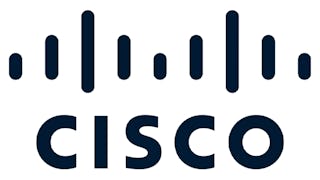As user applications continue to drive network growth and complexity, supporting diverse types of traffic—especially for business-critical and delay-sensitive applications—has never been more essential. This course equips learners with in-demand skills to effectively manage Quality of Service (QoS) in converged networks, ensuring that priority applications receive the performance they require. You’ll explore the foundations of QoS, identify common network issues, and learn step-by-step methods for planning and implementing QoS using modern models like best-effort, IntServ, and DiffServ.

Gain next-level skills with Coursera Plus for $199 (regularly $399). Save now.

Introduction to QoS and QoS Mechanisms
This course is part of Implementing Cisco Quality of Service Specialization

Instructor: Cisco Learning & Certifications
Included with
What you'll learn
Gain an introductory understanding of QoS and its implementation and monitoring
Understand classification and its implementation
Explain the purpose of marking and how it can be used to define a QoS service policy
Skills you'll gain
Details to know

Add to your LinkedIn profile
20 assignments
See how employees at top companies are mastering in-demand skills

Build your subject-matter expertise
- Learn new concepts from industry experts
- Gain a foundational understanding of a subject or tool
- Develop job-relevant skills with hands-on projects
- Earn a shareable career certificate

There are 5 modules in this course
What's included
2 readings
As user applications continue to drive network growth and evolution, the demand to support various types of traffic is also increasing. Network traffic from business-critical and delay-sensitive applications must be serviced with priority and protected from other types of traffic. Quality of service (QoS) is a crucial element of any administrative policy that mandates how to handle application traffic on a network. QoS and its implementations in a converged network are complex and create many challenges for network administrators and architects. Many QoS building blocks or features operate at different parts of a network to create an end-to-end QoS system. Managing how these building blocks are assembled and how different QoS features are used can be a difficult task.
What's included
11 readings6 assignments
Cisco has simplified Quality of Service (QoS) configuration by logically grouping the various components of a QoS policy into reusable configuration modules. These modules constitute the Cisco modular QoS CLI (MQC), which allows network administrators and network implementers to deploy QoS easily. Cisco also provides many mechanisms that assist in the development and monitoring of QoS implementations. These mechanisms allow administrators to perform network discoveries that assist in planning QoS policy and provide monitoring statistics that are used to perform ongoing validation of QoS configurations. There are some instances, however, in which customers do not want to be concerned with the specifics of QoS configuration. These customers would prefer to enable QoS in the LAN or WAN by using one or two commands and to allow the Cisco IOS router or switch to automate the required complex QoS configuration. For these customers, Cisco has developed Cisco AutoQoS.
What's included
13 readings5 assignments
After network traffic is classified, individual packets are colored or marked so that other network devices can apply QoS features uniformly to those packets in compliance with the defined QoS policy. Marking the network traffic allows you to set or modify the attributes for traffic belonging to a specific class. When used in conjunction with network traffic classification, marking the network traffic is the foundation for enabling many quality of service (QoS) features on your network.
What's included
10 readings5 assignments
After network traffic is classified, individual packets are colored or marked so that other network devices can apply QoS features uniformly to those packets in compliance with the defined QoS policy. Marking the network traffic allows you to set or modify the attributes for traffic belonging to a specific class. When used in conjunction with network traffic classification, marking the network traffic is the foundation for enabling many quality of service (QoS) features on your network.
What's included
9 readings4 assignments
Earn a career certificate
Add this credential to your LinkedIn profile, resume, or CV. Share it on social media and in your performance review.
Instructor

Offered by
Explore more from Networking
 Status: Free Trial
Status: Free TrialCisco Learning and Certifications
 Status: Free Trial
Status: Free TrialCisco Learning and Certifications
 Status: Free Trial
Status: Free TrialCisco Learning and Certifications
 Status: Free Trial
Status: Free TrialCisco Learning and Certifications
Why people choose Coursera for their career




Frequently asked questions
To access the course materials, assignments and to earn a Certificate, you will need to purchase the Certificate experience when you enroll in a course. You can try a Free Trial instead, or apply for Financial Aid. The course may offer 'Full Course, No Certificate' instead. This option lets you see all course materials, submit required assessments, and get a final grade. This also means that you will not be able to purchase a Certificate experience.
When you enroll in the course, you get access to all of the courses in the Specialization, and you earn a certificate when you complete the work. Your electronic Certificate will be added to your Accomplishments page - from there, you can print your Certificate or add it to your LinkedIn profile.
Yes. In select learning programs, you can apply for financial aid or a scholarship if you can’t afford the enrollment fee. If fin aid or scholarship is available for your learning program selection, you’ll find a link to apply on the description page.
More questions
Financial aid available,





